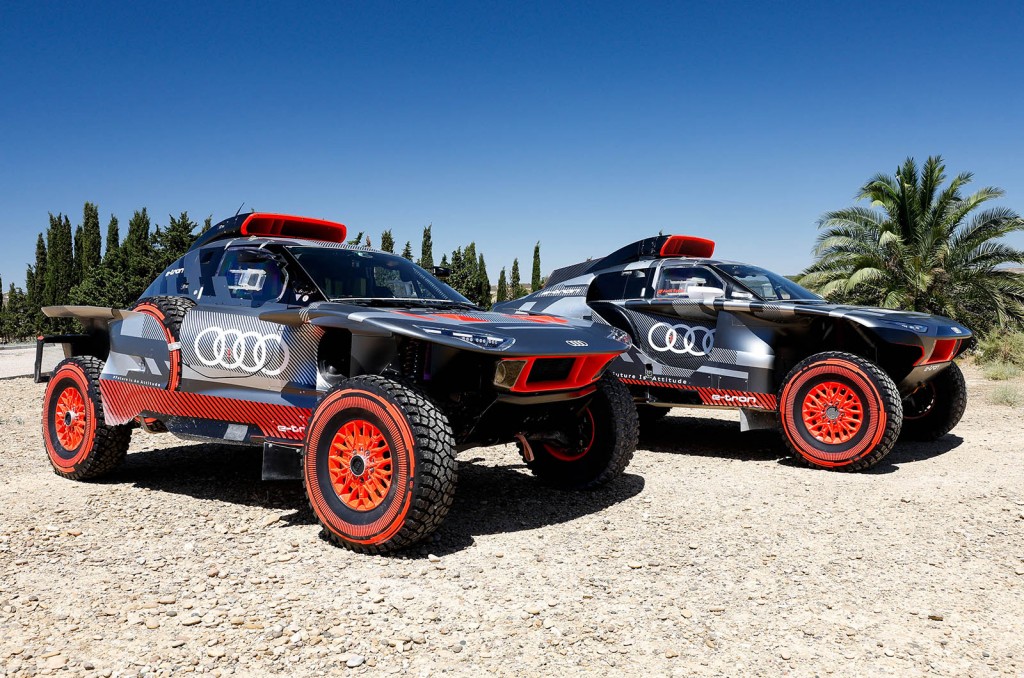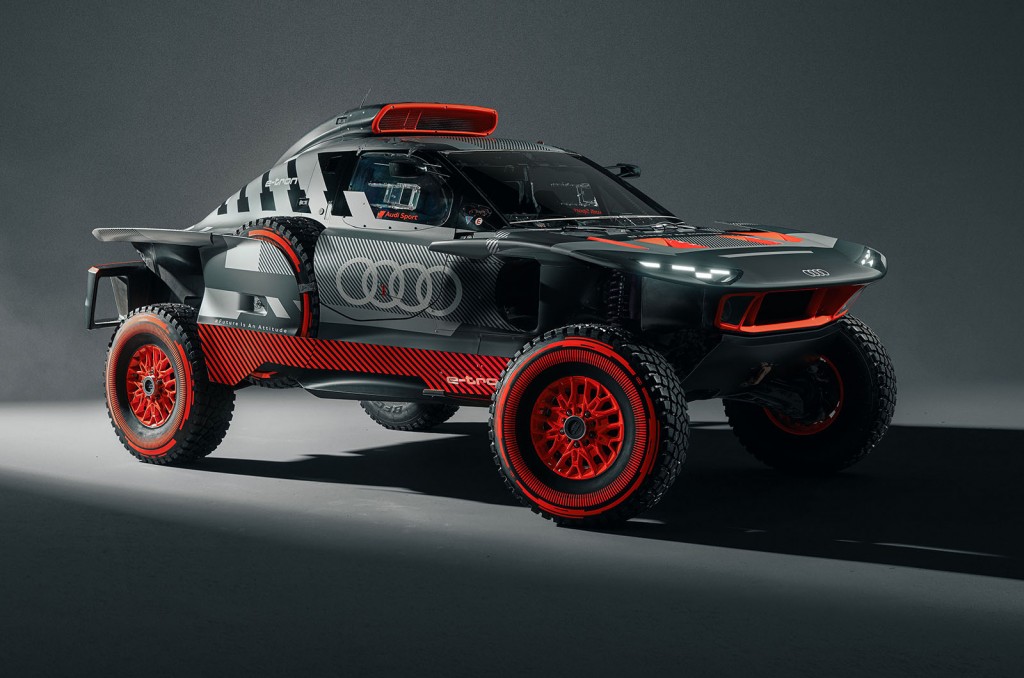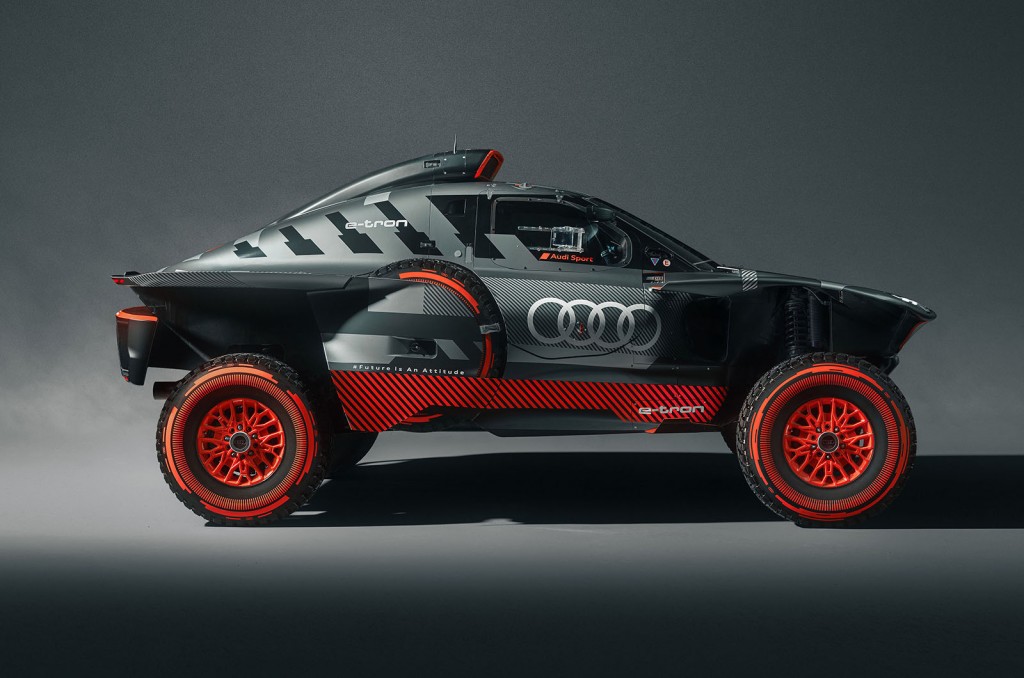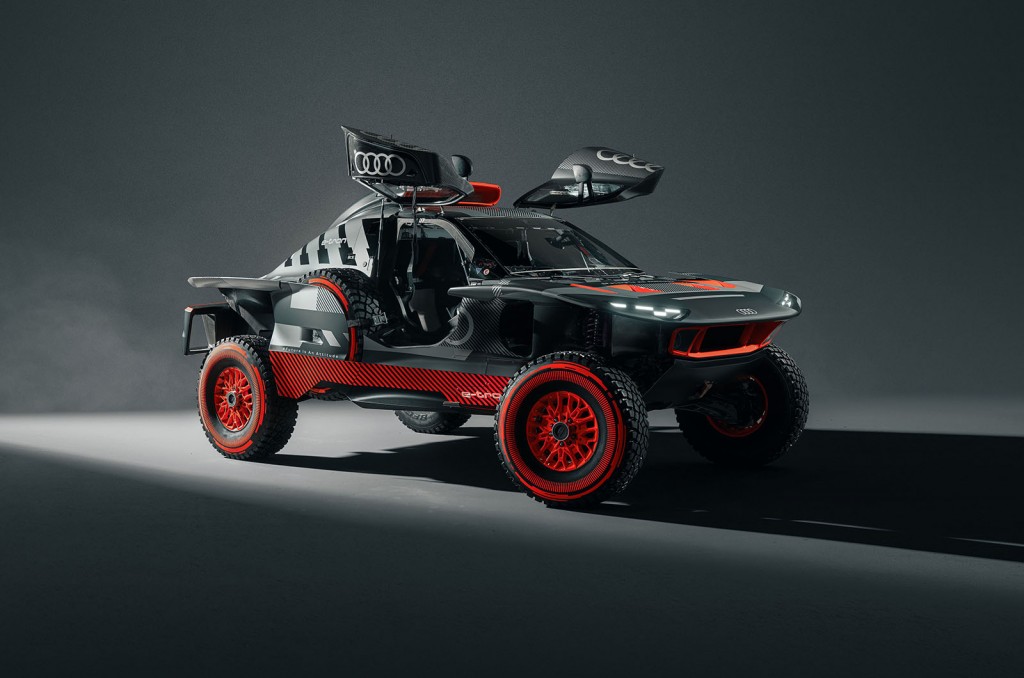
Audi’s motorsport division might be gearing up to enter Formula 1 in 2026, but it has some unfinished business on the Dakar Rally first. And to clear that up, it’s just unveiled the wild new RS Q e-tron E2 rally raid challenger.
It’s an extensively reworked version of the machine the Gerrman firm entered on last January’s Dakar rally raid, which is named for the South American country it used to finish in but now runs entirely in Saudi Arabia.
Electric news wherever you are: subscribe to the FREE Move Electric newsletter
The machine claims four stage wins on the 2022 Dakar, but a series of mechanical problems and incidents meant the best of the three cars finished just ninth overall. It did become the first alternate fuel vehicle to win a rally raid later in the year, but when it comes to this form of motorsport it's all about Dakar. So Audi is out to fix it.
Hence the extensive changes. And they are extensive: Audi says that every single body part has been changed for this new version. That’s why the machine has been renamed the RS Q e-tron E2 – the ‘E2’ designation pays homage to the second-generation versions of the firm’s legendary 1980s Audi Quattro Group B rally beasts.

Audi will shortly start to test the car ahead of its competition debut on the Rally du Maroc in October, ahead of the 2023 Dakar Rally which stars on December 31. And we’ve had an up-close look at what’s changed.
Hang on, do I smell petrol?
We’ll be honest about this: the powertrain of the RS Q e-tron E2 does feature a combustion engine. So you might argue it has no place being covered here on Move Electric, what with us being the home of all things electric. But we’re giving this car special dispensation for two reasons. The first is that it’s really, really cool. The second, far more important reason, is that it’s effectively an electric car that just gets a bit of assistance from an ICE unit.

You see, the 2.0-litre turbocharged petrol engine, which Audi has lifted from its old DTM touring car racer, doesn’t actually drive the wheels of the RS Q e-tron E2. It’s simply there to act as a generator that feeds energy into the 52kWh liquid-cooled battery (which features 13 modules and 266 cells and weighs 370kg).
The energy from that battery is then sent to a pair of Audi MGU05 electric motors that drive the wheels of the car. Each motor, which were developed for Audi’s Formula E programme, drives an axle giving all-wheel-drive. It’s quick, too: it can achieve 0-62mph in less than 4.5 seconds. On a loose surface.

Effectively, then, this is perhaps the world’s most sophisticated range-extender. The ICE is only really there because the Dakar stages are too long to be tackled on battery power alone, and it turns out there aren’t many ultra-fast EV chargers in the middle of the Saudi Arabian desert. Funny that.
Besides, the RS Q e-tron is, in the context of lumbering rally raid beasts, really quite efficient. The engine runs at a set RPM, and uses half the fuel of a regular rally raid car – around 300 litres for the average stage and liaison section.

Still, it’s an electric focused machine, and it’s one that’s helping to push technology forward. Audi has been using it to learn about how electric powertrains cope with being stressed in tough environments, and how they fare being pushed for far longer than other off-road electric competition cars such as rallycross and Extreme E machines.
And since the Audi is one of the first machines to enter the T1U alternatively fuelled vehicle rally raid category, the hope is that it might help drive technology forward so that future Dakar car can run purely on electric power.
Does it have much in common with an Audi Q4 e-tron? In truth, not really. But it might help inform tech on future Audi models, such as a production version of the off-road focused Audi Activesphere concept that was recently revealed. Don't expect the powertrain to be lifted and dropped into a future road model – this is all Formula E and DTM tech that's been developed purely for competition – but some of the findings Audi is learning about power management and aerodynamics will be useful.
Okay, we'll let that engine thing slide. So what’s new about this year’s car?
While it might not look like it from a brief glimpse, the bodywork of the RS Q e-tron E2 has been dramatically reworked. “It does not accept a single body part from its predecessor,” notes chief designer Axel Löffler, with a note of pride.
With the focus for last year largely on refining the powertrain, this time the team put a development emphasis on refining the aerodynamics. While you might not think that aerodynamics was a key focus for lumbering rally raid machines that are clambering massive sand dunes, Loffler insists their influence “should not be underestimated”.

The machine has been redesigned with a shape that is somewhat reminiscent of a boat’s hull: the widest point is at the cockpit, and it tapers significantly at both the front and back. Audi has also ditched several bodywork parts, including what it called the ‘elephant foot’ fenders that say between the front wheels and the doors. It's been on a shrink wrap diet, basically.
It’s now 4670mm long, 2300mm high and 1950mm wide, making it around 170mm longer than the previous version. But it's considerably sleeker. As driver Matthias Ekstrom puts it: "It looks like an F1 car for the desert now."

In total, the car’s overall drag has been reduced by 15 per cent. But that doesn’t make the car any faster: the top speed of 105mph is actually set by the T1U rally raid rules. Instead, the reduced drag makes the car more efficient. “It further reduces the energy requirements”, adds Loffler. That means it uses less electricity, which means there’s less need for that ICE unit to chug out its fumes.
The drag improvements come despite new rules that mean Audi has had to make the cockpit larger. That’s good news for the driver and co-drive teams, though, and has given Audi the chance to make some changes to the interior layout. The displays and the controls have been reworked for each of use, with a new rotary switch giving access to four groups of controls. So crews can select ‘Stage’ and ‘Road’ themes, and only get the controls they need for that particular moment.
Meanwhile, the reworked bodywork also includes new removable components to give easier access to the spare wheels and tools, making it quicker and easier to change a punctured tyre. Punctures are a regular problem when you’re running at high speed over desert tracks.
The design tweaks have also made the car lighter, although that’s still different from light: the T1U class has a minimum weight of 2100kg (up from 2000kg last year), and the RQ Q e-tron E2 is still comedy above that.
So has Audi made any changes to the powertrain?
Despite its huge complexity Audi seemed to get the the range-extender powertrain of the car largely right at its first attempt. And in the sport of 'if it ain’t broke', the firm hasn't really tried to fix it.
Still, Audi it has made some minor but significant changes based on its experience from last season. At the Dakar Rally it that the car experienced short-term power surpluses when it was jumping or crossing uneven terrain, leading to rule makers to impose a two-kilojoule ‘excess energy threshold’.

So Audi has remapped the software to fine-tine the power controllers with individual limits for each motor that are constantly recalibrated. “We could have made it easy on ourselves and set our threshold several kilowatts lower, but that would have meant performance disadvantages,” said software engineer Florian Semlinger. “Instead, we put a lot of fine-tuning into the power controllers.”
The control of the auxiliary consumers – the servo pump, air conditioning and fans – have also been reworked to reduce their energy consumption. Audi says that has a “measurable impact” on energy usage. An example: the previous air conditioning system was so strong it could cause the coolant to freeze when running at maximum power. It will not run in an intermittent mode, which reduces power but still controls the interior temperature.
When does the Audi RS Q e-tron E2 hit the road?
The machine has already started testing, and will make its competitive debut on the Rally du Maroc in Marocco on October 1-6. The 2023 Dakar Rally starts in Saudi Arabia on December 31 and runs until January 15.
Audi’s line-up will remain unchanged, with three cars for the crews of Mattias Ekstrom/Emil Bergkvist, Stephane Peterhansel/Edouard Boulanger and Carlos Sainz/Lucas Cruz.
And the goal? Well, new Audi Motorsport boss Rolf Michl is clear that expectations are higher in year two. "The target is clear: the first year we learned, this time we want to achieve a podium," he says. "It will be tough, but we don’t go to attack this event for a second time with less expectation.”
READ MORE
Subscribe to the Move Electric newsletter
e-CARS
Video: Can the National Grid cope with a surge in electric vehicles?
e-BIKES
What to look for when buying an e-bike: Move Electric's top tips
The rise of Volt Bikes: 'when we launched, people thought we were mad'
e-MOTORBIKES
Maeving RM1 electric motorbike review
Q&A: Zapp founder on why electric mopeds are the future
Government plans 2035 ban on new non-zero emission motorbike sales
e-SCOOTERS
Tier to upgrade e-scooter fleet with a smart 'Parrot'
Q&A: Neuron Mobility's UK boss on e-scooters, safety and helmet selfies
e-WORLD
Polestar to supply battery tech to electric boat firm Candela
Engineering giant ABB working on electric Dover-Calais ferry

